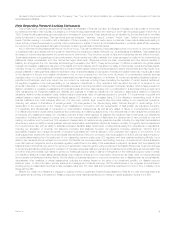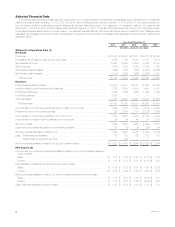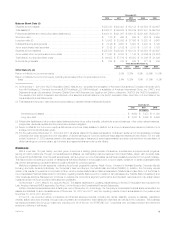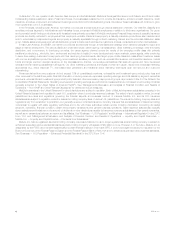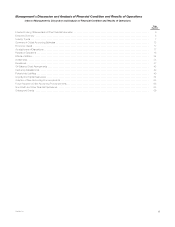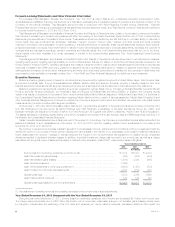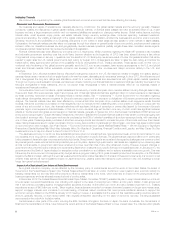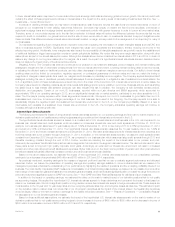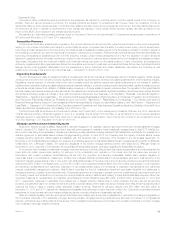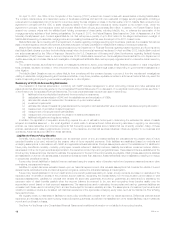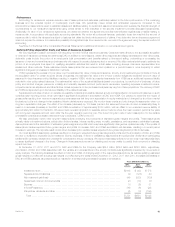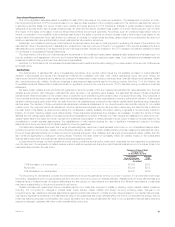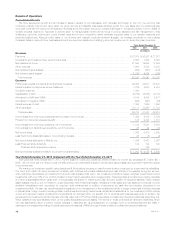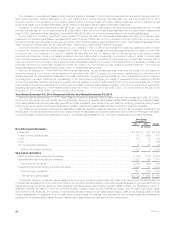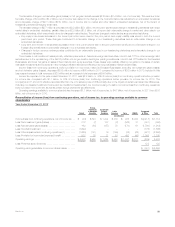MetLife 2012 Annual Report Download - page 17
Download and view the complete annual report
Please find page 17 of the 2012 MetLife annual report below. You can navigate through the pages in the report by either clicking on the pages listed below, or by using the keyword search tool below to find specific information within the annual report.Corporate & Other
Corporate & Other contains the surplus portfolios for the enterprise, as well as the portfolios used to fund the capital needs of the Company. In
addition, there are various reinsurance products. The surplus portfolios are subject to reinvestment risk; however lower net investment income is
significantly offset by lower interest expense on both fixed and variable rate debt. Under a lower interest rate environment, fixed rate debt is assumed to
be either paid off when it matures or refinanced at a lower interest rate resulting in lower overall interest expense. Variable rate debt is indexed to the
three-month LIBOR, which results in lower interest expense incurred.
We estimate an unfavorable operating earnings impact in Corporate & Other from the hypothetical U.S. interest rate stress scenario noted above of
$15 million and $40 million in 2013 and 2014, respectively.
Competitive Pressures
The life insurance industry remains highly competitive. The product development and product life-cycles have shortened in many product segments,
leading to more intense competition with respect to product features. Larger companies have the ability to invest in brand equity, product development,
technology and risk management, which are among the fundamentals for sustained profitable growth in the life insurance industry. In addition, several of
the industry’s products can be quite homogeneous and subject to intense price competition. Sufficient scale, financial strength and financial flexibility are
becoming prerequisites for sustainable growth in the life insurance industry. Larger market participants tend to have the capacity to invest in additional
distribution capability and the information technology needed to offer the superior customer service demanded by an increasingly sophisticated industry
client base. We believe that the continued volatility of the financial markets, its impact on the capital position of many competitors, and subsequent
actions by regulators and rating agencies have altered the competitive environment. In particular, we believe that these factors have highlighted financial
strength as the most significant differentiator from the perspective of some customers and certain distributors. We believe the Company is well
positioned to compete in this environment. See “Business — Competition” in the 2012 Form 10-K.
Regulatory Developments
The U.S. life insurance industry is regulated primarily at the state level, with some products and services also subject to Federal regulation. As life insurers
introduce new and often more complex products, regulators refine capital requirements and introduce new reserving standards for the life insurance industry.
Regulations recently adopted or currently under review can potentially impact the statutory reserve and capital requirements of the industry. In addition,
regulators have undertaken market and sales practices reviews of several markets or products, including equity-indexed annuities, variable annuities and group
products, as well as reviews of the utilization of affiliated captive reinsurers or off-shore entities to reinsure insurance risks. The regulation of the global financial
services industry has received renewed scrutiny as a result of the disruptions in the financial markets. Significant regulatory reforms have been recently adopted
and additional reforms proposed, and these or other reforms could be implemented. See “Business – U.S. Regulation,” “Business – International Regulation,”
“Risk Factors — Regulatory and Legal Risks — Our Insurance and Brokerage Businesses Are Highly Regulated, and Changes in Regulation and in Supervisory
and Enforcement Policies May Reduce Our Profitability and Limit Our Growth,” “Risk Factors — Risks Related to Our Business — Our Statutory Life Insurance
Reserve Financings May Be Subject to Cost Increases and New Financings May Be Subject to Limited Market Capacity,” and “Risk Factors — Regulatory and
Legal Risks — Changes in U.S. Federal and State Securities Laws and Regulations, and State Insurance Regulations Regarding Suitability of Annuity Product
Sales, May Affect Our Operations and Our Profitability” in the 2012 Form 10-K.
The Dodd-Frank Wall Street Reform and Consumer Protection Act (“Dodd-Frank”), which was signed by President Obama in July 2010, effected the
most far-reaching overhaul of financial regulation in the U.S. in decades. The full impact of Dodd-Frank on us will depend on the numerous rulemaking
initiatives required or permitted by Dodd-Frank which are in various stages of implementation, many of which are not likely to be completed for some
time. See “Business – U.S. Regulation” in the 2012 Form 10-K.
Mortgage and Foreclosure-Related Exposures
Since 2008, MetLife, through its affiliate, MetLife Bank, has been engaged in the origination, sale and servicing of forward and reverse residential mortgage
loans. In January 2012, MetLife, Inc. announced that it was exiting the business of originating forward residential mortgage loans. In April 2012, MetLife, Inc.
announced it was exiting the businesses of originating and servicing reverse residential mortgage loans and that MetLife Bank and MetLife, Inc. entered into a
definitive agreement to sell MetLife Bank’s reverse mortgage servicing portfolio. In June 2012, the Company sold the majority of MetLife Bank’s reverse
mortgage servicing rights and related assets and liabilities, with the remainder sold in September 2012 pursuant to the same sales agreement. On
November 2, 2012, MetLife Bank and MetLife, Inc. entered into a definitive agreement to sell MetLife Bank’s forward mortgage servicing portfolio to JPMorgan
Chase Bank, N.A. (“JPMorgan Chase”). The rights and obligations of the forward mortgage servicing portfolio were assumed by JPMorgan Chase on
December 31, 2012. See Note 3 of the Notes to the Consolidated Financial Statements for information regarding the MetLife Bank Divestiture.
In conjunction with the sales of residential mortgage loans and servicing portfolios, MetLife Bank has made representations and warranties that the
loans sold met certain requirements (relating, for example, to the underwriting and origination of the loans), and that the loans were serviced in
accordance with investor guidelines. Notwithstanding its exit from the origination and servicing businesses, MetLife Bank remains obligated to
repurchase loans or compensate for losses upon demand due to alleged defects by MetLife Bank or its predecessor servicers in past servicing of the
loans and material representations made in connection with MetLife Bank’s sale of the loans. At the time the servicing portfolios were sold MetLife Bank
was servicing $75.2 billion in mortgage loans, of which $58.9 billion were originated by MetLife Bank, and which loans were subject to both origination
and servicing representations and warranties. Estimation of repurchase liability arising from breaches of origination representations and warranties
requires considerable management judgment. MetLife Bank considers the level of outstanding unresolved repurchase demands and challenges to
mortgage insurance, probable future demands in light of historical experience and changes in general economic conditions such as unemployment and
the housing market, and the likelihood of recovery from indemnifications made to MetLife Bank relating to loans that MetLife Bank acquired rather than
originated. Reserves for representation and warranty repurchases and indemnifications were $95 million and $69 million at December 31, 2012 and
2011, respectively. Reserves for estimated future losses due to alleged servicing deficiencies on loans originated and sold, as well as servicing
acquired, are estimated based on unresolved claims as well as projected losses under investor servicing contracts where MetLife Bank’s past actions or
inactions are likely to result in missing certain stipulated investor timelines. Reserves for servicing defects were $54 million and $26 million at
December 31, 2012 and 2011, respectively. Management is satisfied that adequate provision has been made in the Company’s consolidated financial
statements for those representation and warrant obligations that are currently probable and reasonably estimable.
State and federal regulatory and law enforcement authorities have initiated various inquiries, investigations or examinations of alleged irregularities in
the foreclosure practices of the residential mortgage servicing industry. Mortgage servicing practices have also been the subject of Congressional
attention. Authorities have publicly stated that the scope of the investigations extends beyond foreclosure documentation practices to include mortgage
loan modification and loss mitigation practices.
MetLife, Inc. 11


